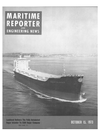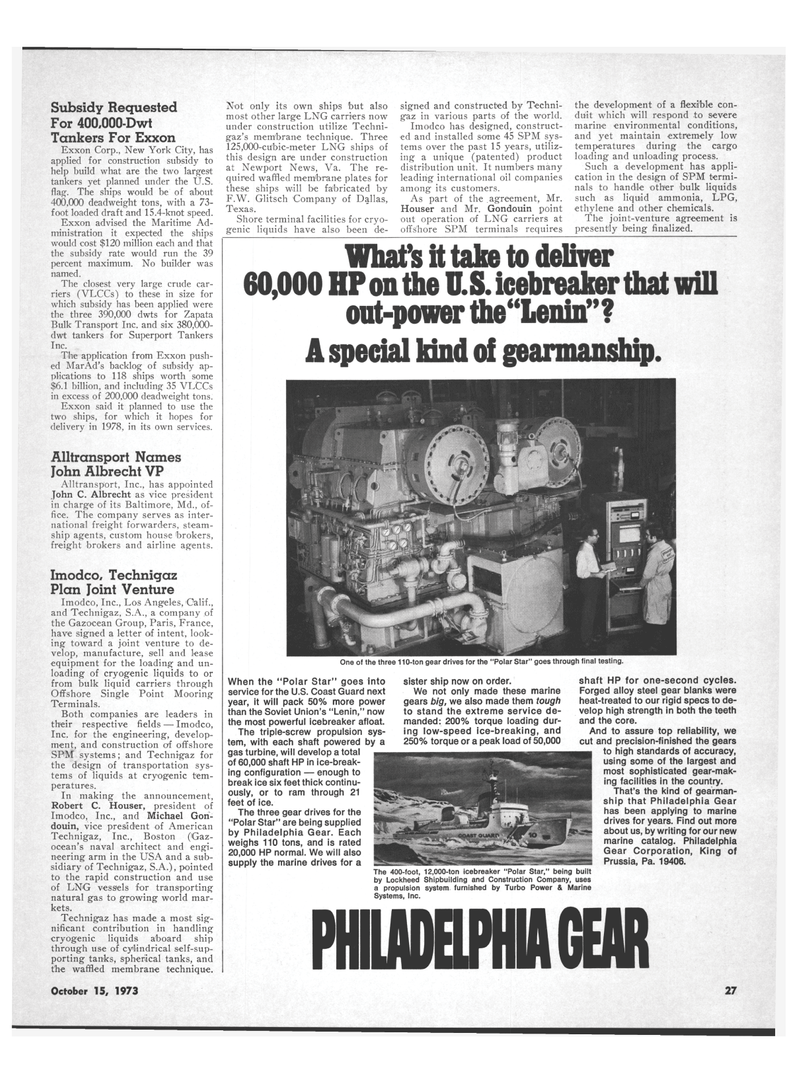
Page 21: of Maritime Reporter Magazine (October 15, 1973)
Read this page in Pdf, Flash or Html5 edition of October 15, 1973 Maritime Reporter Magazine
Subsidy Requested
For 400,000-Dwt
Tankers For Exxon
Exxon Corp., New York City, has applied for construction subsidy to help build what are the two largest tankers yet planned under the U.S. flag. The ships would be of about 400,000 deadweight tons, with a 73- foot loaded draft and 15.4-knot speed.
Exxon advised the Maritime Ad- ministration it expected the ships would cost $120 million each and that the subsidy rate would run the 39 percent maximum. No builder was named.
The closest very large crude car- riers (VLCCs) to these in size for which subsidy has been applied were the three 390,000 dwts for Zapata
Bulk Transport Inc. and six 380,000- dwt tankers for Superport Tankers
Inc.
The application from Exxon push- ed MarAd's backlog of subsidy ap- plications to 118 ships worth some $6.1 billion, and including 35 VLCCs in excess of 200,000 deadweight tons.
Exxon said it planned to use the two ships, for which it hopes for delivery in 1978, in its own services.
Alltransport Names
John Albrecht VP
Alltransport, Inc., has appointed
John C. Albrecht as vice president in charge of its Baltimore, Md., of- fice. The company serves as inter- national freight forwarders, steam- ship agents, custom house brokers, freight brokers and airline agents.
Imodco, Technigaz
Plan Joint Venture
Imodco, Inc., Los Angeles, Calif., and Technigaz, S.A., a company of the Gazocean Group, Paris, France, have signed a letter of intent, look- ing toward a joint venture to de- velop, manufacture, sell and lease equipment for the loading and un- loading of cryogenic liquids to or from bulk liquid carriers through
Offshore Single Point Mooring
Terminals.
Both companies are leaders in their respective fields — Imodco,
Inc. for the engineering, develop- ment, and construction of offshore
SPM systems; and Technigaz for the design of transportation sys- tems of liquids at cryogenic tem- peratures.
In making the announcement,
Robert C. Houser, president of
Imodco, Inc., and Michael Gori- douin, vice president of American
Technigaz, Inc., Boston (Gaz- ocean's naval architect and engi- neering arm in the USA and a sub- sidiary of Technigaz, S.A.), pointed to the rapid construction and use of LNG vessels for transporting natural gas to growing world mar- kets.
Technigaz has made a most sig- nificant contribution in handling cryogenic liquids aboard ship through use of cylindrical self-sup- porting tanks, spherical tanks, and the waffled membrane technique.
Not only its own ships but also most other large LNG carriers now under construction utilize Techni- gaz's membrane technique. Three 125,000-cubic-meter LNG ships of this design are under construction at Newport News, Va. The re- quired waffled membrane plates for these ships will be fabricated by
F.W. Glitsch Company of Dallas,
Texas.
Shore terminal facilities for cryo- genic liquids have also been de- signed and constructed by Techni- gaz in various parts of the world.
Imodco has designed, construct- ed and installed some 45 SPM sys- tems over the past 15 years, utiliz- ing a unique (patented) product distribution unit. It numbers many leading international oil companies among its customers.
As part of the agreement, Mr.
Houser and Mr. Gondouin point out operation of LNG carriers at offshore SPM terminals requires the development of a flexible con- duit which will respond to severe marine environmental conditions, and yet maintain extremely low temperatures during the cargo loading and unloading process.
Such a development has appli- cation in the design of SPM termi- nals to handle other bulk liquids such as liquid ammonia, LPG, ethylene and other chemicals.
The joint-venture agreement is presently being finalized.
What's it take to deliver 60,000 HP on the U.S. icebreaker that will out-power the "Lenin"?
A special kind of gearmanship.
One of the three 110-ton gear drives for the "Polar Star" goes through final testing.
PHUUBPHH GEM
When the "Polar Star" goes into service for the U.S. Coast Guard next year, it will pack 50% more power than the Soviet Union's "Lenin," now the most powerful icebreaker afloat.
The triple-screw propulsion sys- tem, with each shaft powered by a gas turbine, will develop a total of 60,000 shaft HP in ice-break- ing configuration — enough to break ice six feet thick continu- ously, or to ram through 21 feet of ice.
The three gear drives for the "Polar Star" are being supplied by Philadelphia Gear. Each weighs 110 tons, and is rated 20,000 HP normal. We will also supply the marine drives for a sister ship now on order.
We not only made these marine gears big, we also made them tough to stand the extreme service de- manded: 200% torque loading dur- ing low-speed ice-breaking, and 250% torque or a peak load of 50,000 shaft HP for one-second cycles.
Forged alloy steel gear blanks were heat-treated to our rigid specs to de- velop high strength in both the teeth and the core.
And to assure top reliability, we cut and precision-finished the gears to high standards of accuracy, using some of the largest and most sophisticated gear-mak- ing facilities in the country.
That's the kind of gearman- ship that Philadelphia Gear has been applying to marine drives for years. Find out more about us, by writing for our new marine catalog. Philadelphia
Gear Corporation, King of
Prussia, Pa. 19406.
The 400-foot, 12,000-ton icebreaker "Polar Star," being built by Lockheed Shipbuilding and Construction Company, uses a propulsion system furnished by Turbo Power & Marine
Systems, Inc.
October 15, 1973 11

 20
20

 22
22
